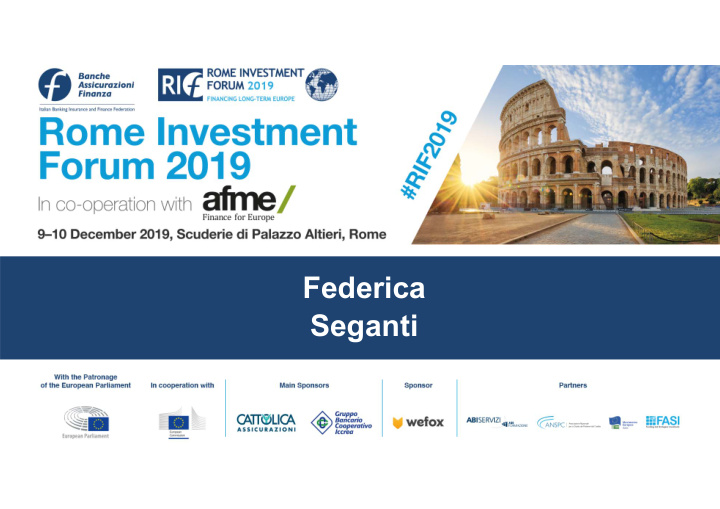



Federic a Segant i
Alternative Finance: The Potential Italian market Flows of bank loans to companies (non- financial) from 2001 to 2019: Euro area vs Italy ▪ The amount of bank loans to euro area (Normalized - Base year 2001) * companies (shown in orange) appears to have decreased by less than 10% since the crisis at the beginning of 2009 to the reporting date (July 2019); ▪ in Italy the decrease in the amount of bank loans to businesses (shown in white) was more pronounced than in the Euro Area, standing at over 25%, equal to a decrease of approximately Euro 250 billion (from Euro 910 to Euro 660 billion); ▪ alternative solutions of financial support for business development plans are therefore a topical issue not only in Italy but also throughout Europe. *Sorce: Bloomberg | 1 |
Alternative Finance: The Potential Italian Market Industrial Production Trend from 2001 to 2019: Euro area vs Italy ▪ After the deep slowdown recorded in (Normalized - Base year 2001) * 2009, the Industrial Production of the Euro Area (shown in orange) - to which Italy also contributes significantly - has systematically resumed growth; ▪ at the end of 2017, the level recorded in the Industrial Production of the Euro Area almost equaled that reached before the crisis. Signs of a slowdown have been seen since the second half of 2018, mainly due to the contraction in Germany; ▪ the Italian Industrial Production (shown in white) has not yet recovered the levels recorded in the period before the crisis (a gap of about 20% remains). *Source: Bloomberg | 2 |
Funding sources for European SMEs - Development Funding sources for European SMEs (compared to the previous six months) * *Survey on the Access to Finance of Enterprises in the euro area − April to September 2018. European Central Bank Traditional Finance Alternative Finance Self-financing ▪ The European SME system continues to be based on a logic of supplying financial resources from the banking system; ▪ the process of bank deleveraging - also connected to compliance with the constraints of the evolution of supervisory regulations (Basel 3) - required a greater contribution from the self-financing produced to support the company development programs; ▪ alternative financing instruments (Equity, Minibond, Factoring) are still used to a limited extent by European SMEs.
Italian Alternative Finance Industry Development Source: Politecnico Survey ▪ In the last decade private equity and venture capital represented the main source of cash, while in the last 18 months mini-bond and invoice tradind represent the most relevant opportunities ▪ Politecnico Sirvey estimate that only 1.800 Italian SMEs (representing 1% of the potential number of SMEs) took the opportunity to rise money from alternative channels
Funding sources for Italian SMEs - Development 12% 21% 12% % Distribution of the number of Minibonds by turnover 16% class (Mln Euro) of the issuing companies in 2018 * around 1/3 18% 17% 4% *Source: AIFI - Deloitte ▪ In Italy the Minibond market registered issues for Euro 25.2 billion in 2018, of which issued by SMEs for Euro 4.6 billion; ▪ the analyzes conducted by AIFI (Italian Association of Private Equity, Venture Capital and Private Debt) show that minibond issues have affected SMEs belonging to various size classes; ▪ over one third of the issues completed during 2018 concerned SMEs with turnover of less than Euro 30 million.
MINIBOND – Market Focus 2018 Distribution of the number of investments sorted by the Distribution of the amount invested sorted by the purposes purposes pursued by the issuer pursued by the issuer Source: AIFI - Deloitte ▪ Growth financing is the main objective pursued with funding raised through the issue of Minibonds; ▪ the internal growth (dark blue) records the greatest number of emissions but not the highest sum of the capitals; ▪ external growth involves significant capital raising.
MINIBOND – Market Focus 2018 Distribution of the Minibond maturity: difference between Distribution of the Minibond coupon ** SMEs and large companies ** 104 PMI Grandi Imprese 177 169 180 100 93 87 147 150 77 80 71 69 115 120 60 54 90 69 39 40 60 28 26 30 20 20 19 19 24 20 30 13 10 10 2 0 0 Meno 4% tra 4% e 5% tra 5% e 6% tra 6% e 7% tra 7% e 8% tra 8% e 9% oltre 9% Variabile Zero Fino 1 anno tra 1 e 2 anni tra 2 e 3 anni tra 3 e 4 anni tra 4 e 5 anni tra 5 e 6 anni tra 6 e 7 anni oltre 7 anni Coupon Valore medio complessivo dei titoli a cedola fissa: 5,10% ** Source: Osservatorio Politecnico Milano ▪ No significant differences emerged in the choice of the duration of the Minibonds between SMEs compared and Large Companies; ▪ SMEs also use the tool to support short-term planning (including net working capital)
www.mib.edu
Recommend
More recommend